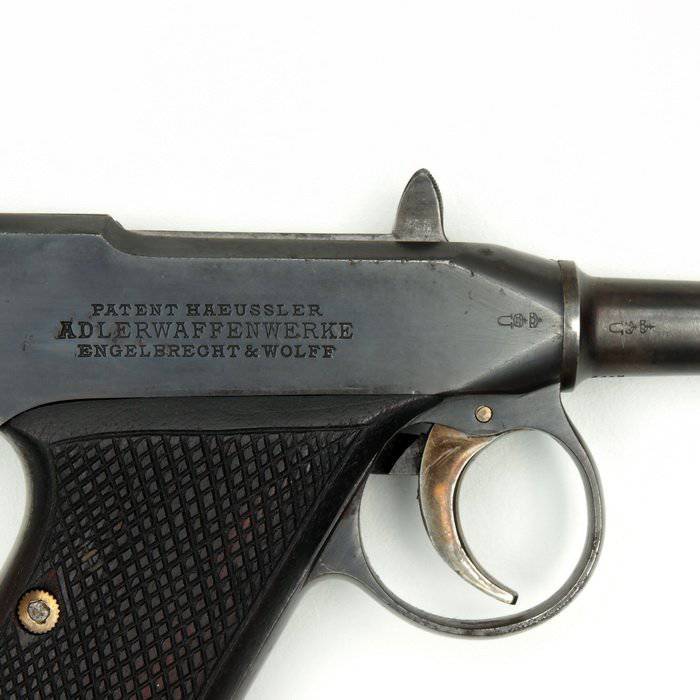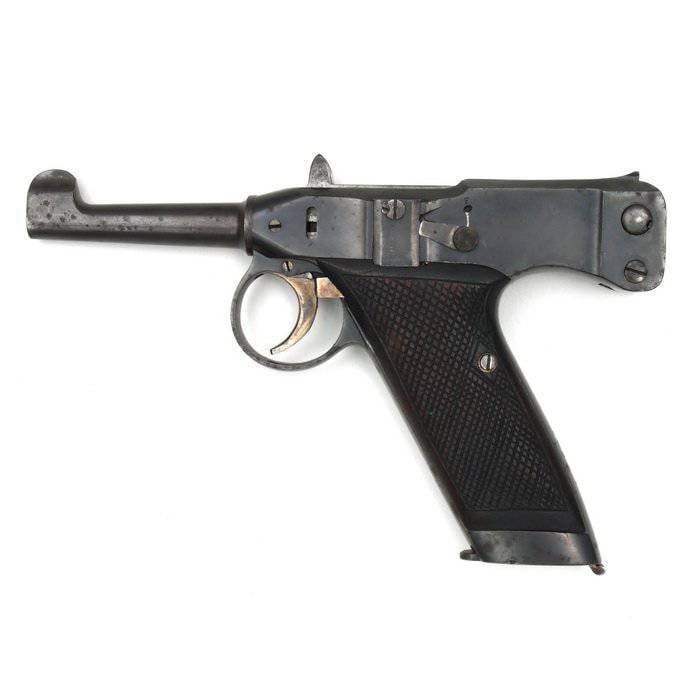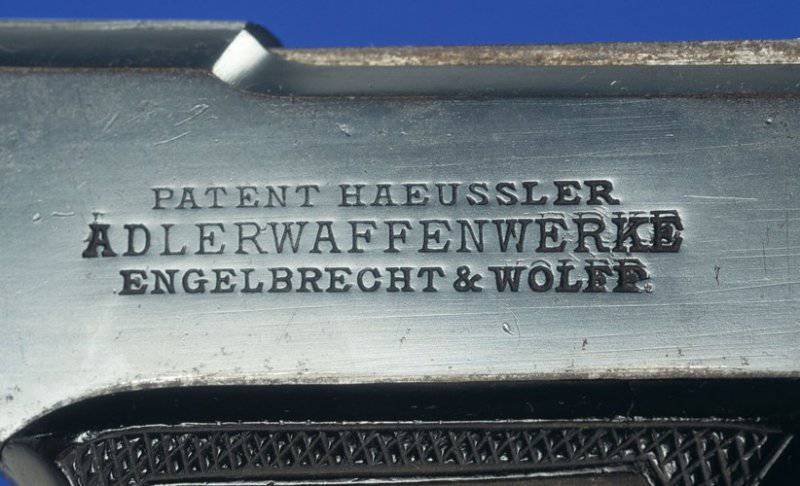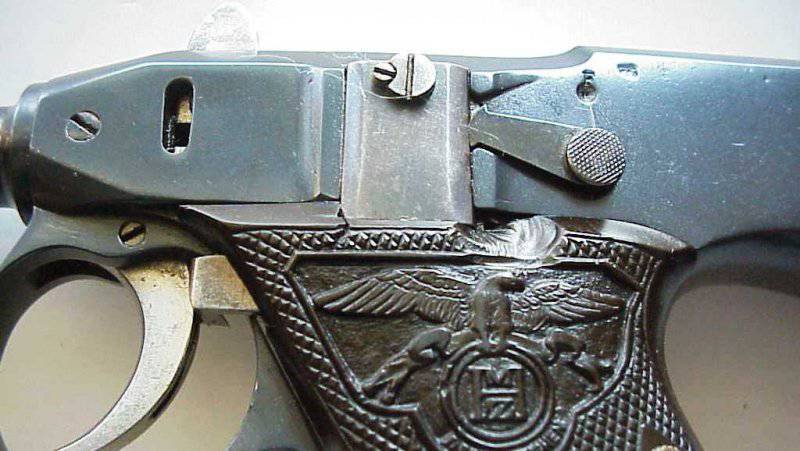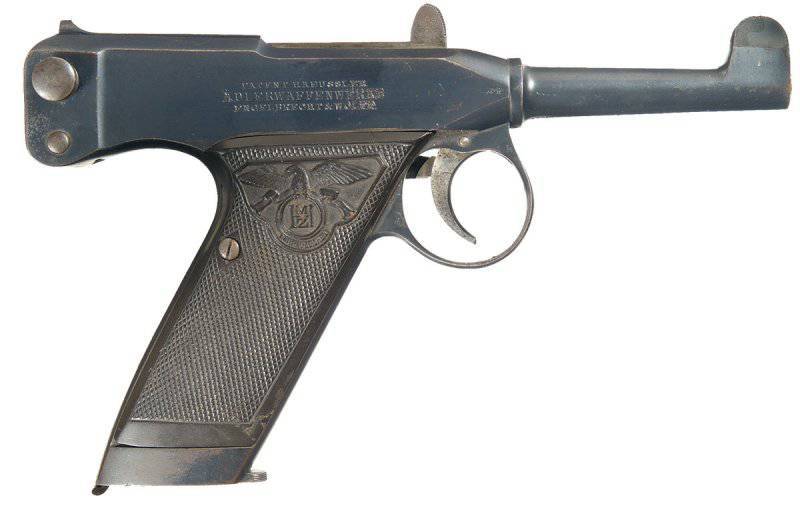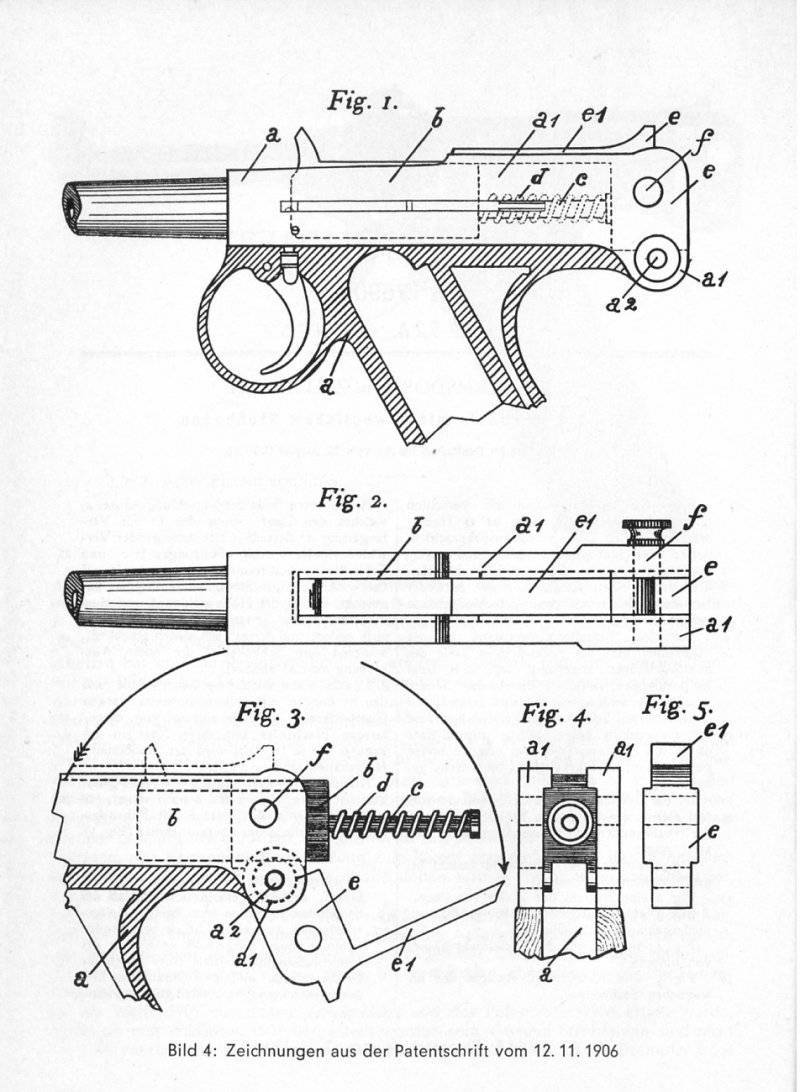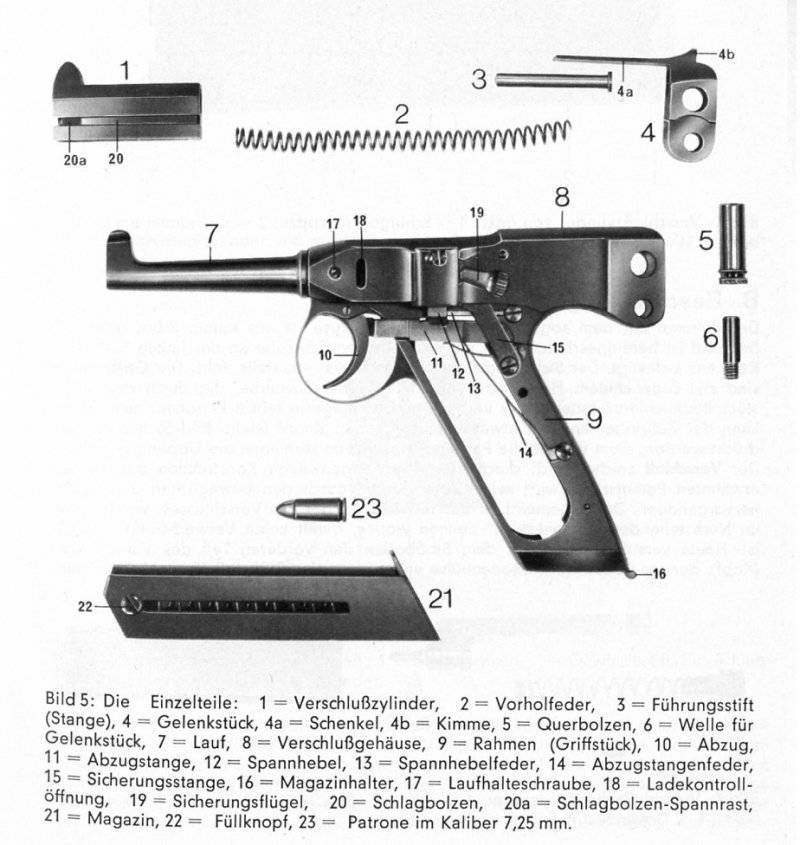Adler Pistol
January 5 201310
Gunshot weapon At the end of the nineteenth and early twentieth centuries, it stands out among all the other samples by the unique design and bold decisions that gunsmiths of the time used in their offspring. It was at this time that the foundations of the weapons business were laid, and the designers searched for solutions that would provide high accuracy, reliability and durability, which explains the variety of different designs of firearms of the time. With one of the not-so-ordinary samples, we will meet in this article. It’s about the gun Adler, which in German means “Eagle”.
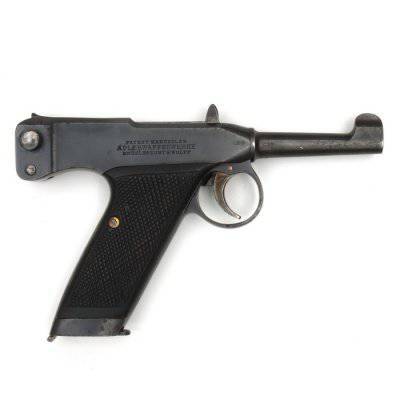 This weapon is not widely used, but despite this, quite interesting, while years old, it was in the 1905 year, many questions arise about who exactly is its legal constructor. Or rather, who invented the pistol is known, it was the designer Heusler, for whom serially produced weapons are no longer listed, but who owns the rights to this pistol story foggy. So, in 1905, 22 August, the rights to this gun were declared by a completely different person, Max Hermsdorff, and only on November 12, 1906, he received a patent for this weapon. Such a decent period for obtaining a patent can only say that a dispute has arisen about the authorship of the invention, but that this was unknown. Perhaps the idea was visited by two bright minds at the same time, and it is possible that Houssler transferred the rights to the weapon to Hermsdorff, and this time was spent to arrange everything in accordance with the law. Nevertheless, Hermsdorff and Heusler came to some general decision, because despite the fact that the patent does not mention the Heusler name, it is marked on the weapon itself, and completely, but the name Hermsdorff is indicated only in the form of three capital letters HMZ on the grip pad, and if the former refer to the name of the patent owner, the latter most likely indicates the place where the weapon was made, but I can not vouch for the correctness of this interpretation.
This weapon is not widely used, but despite this, quite interesting, while years old, it was in the 1905 year, many questions arise about who exactly is its legal constructor. Or rather, who invented the pistol is known, it was the designer Heusler, for whom serially produced weapons are no longer listed, but who owns the rights to this pistol story foggy. So, in 1905, 22 August, the rights to this gun were declared by a completely different person, Max Hermsdorff, and only on November 12, 1906, he received a patent for this weapon. Such a decent period for obtaining a patent can only say that a dispute has arisen about the authorship of the invention, but that this was unknown. Perhaps the idea was visited by two bright minds at the same time, and it is possible that Houssler transferred the rights to the weapon to Hermsdorff, and this time was spent to arrange everything in accordance with the law. Nevertheless, Hermsdorff and Heusler came to some general decision, because despite the fact that the patent does not mention the Heusler name, it is marked on the weapon itself, and completely, but the name Hermsdorff is indicated only in the form of three capital letters HMZ on the grip pad, and if the former refer to the name of the patent owner, the latter most likely indicates the place where the weapon was made, but I can not vouch for the correctness of this interpretation.
One of the notable features of this gun is that it used specially designed for it ammunition caliber 7 millimeters and sleeve length 25 millimeters. Unfortunately, practically nothing is known about this ammunition, but it can be assumed that it was created on the basis of the “Mauser” 7,63х25. Creating your own ammunition for a pistol, the more similar in characteristics to one of the most common 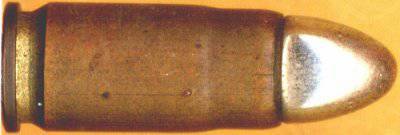 at that time, pistol cartridges indicated that it was planned to produce weapons massively enough, and great hopes were pinned on it, but, as we know, this weapon was never found. In total, less than 2 of thousands of weapons were produced, so this kind of gun is very rare and costs a lot of money. These guns were produced shortly from 1905 to 1907 a year, and after their production was curtailed due to great competition.
at that time, pistol cartridges indicated that it was planned to produce weapons massively enough, and great hopes were pinned on it, but, as we know, this weapon was never found. In total, less than 2 of thousands of weapons were produced, so this kind of gun is very rare and costs a lot of money. These guns were produced shortly from 1905 to 1907 a year, and after their production was curtailed due to great competition.
By itself, the gun is a really interesting and unique design that can rarely be found in other models of weapons. 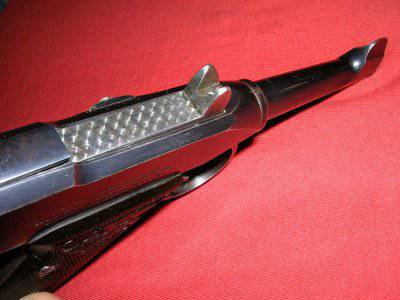 The pistol is a frame in which the barrel is installed, and behind it is a movable shutter of the weapon inside the frame. The bolt has a cocking handle in the upper part, and a hinged part is fixed on the back side (I cannot think of a name for it), which props the bolt from behind and from above and does not allow it to pop out of the pistol frame. On the same part there is an unregulated rear sight, and the part itself is fixed by a pin passing through it and the frame of the weapon. The recoil spring is located behind the bolt and has a guide rod that, when the valve is retracted, protrudes backwards from the locking reversing part that locks the bolt. The principle of operation of the weapon is based on the free gate, which indicates a smaller weight of gunpowder in 7x25 cartridges than in the “Mauser”, with which the use of such a scheme in a relatively compact sample is difficult. When fired, the powder gases push not only the bullet forward, but also the sleeve back. However, since the sleeve supports the bolt of the weapon, which is much heavier than the bullet, and is also spring loaded by the return spring, the sleeve does not rush in the direction of the shooter, pushing the bolt, and gives it enough momentum to roll back. That is, as a result, not the sleeve pushes the bolt, but the bolt pulls the cartridge case behind itself, maintaining the momentum gained due to its weight. Moving back, the bolt removes the cartridge case and compresses the return spring. Having reached its extreme rear point, under the influence of the return spring, the bolt begins to move forward, and a new cartridge is removed from the magazine and inserted into the chamber, and the firing mechanism is cocked. Further, after pressing the trigger, the drummer is again released, hits the primer, and a shot takes place.
The pistol is a frame in which the barrel is installed, and behind it is a movable shutter of the weapon inside the frame. The bolt has a cocking handle in the upper part, and a hinged part is fixed on the back side (I cannot think of a name for it), which props the bolt from behind and from above and does not allow it to pop out of the pistol frame. On the same part there is an unregulated rear sight, and the part itself is fixed by a pin passing through it and the frame of the weapon. The recoil spring is located behind the bolt and has a guide rod that, when the valve is retracted, protrudes backwards from the locking reversing part that locks the bolt. The principle of operation of the weapon is based on the free gate, which indicates a smaller weight of gunpowder in 7x25 cartridges than in the “Mauser”, with which the use of such a scheme in a relatively compact sample is difficult. When fired, the powder gases push not only the bullet forward, but also the sleeve back. However, since the sleeve supports the bolt of the weapon, which is much heavier than the bullet, and is also spring loaded by the return spring, the sleeve does not rush in the direction of the shooter, pushing the bolt, and gives it enough momentum to roll back. That is, as a result, not the sleeve pushes the bolt, but the bolt pulls the cartridge case behind itself, maintaining the momentum gained due to its weight. Moving back, the bolt removes the cartridge case and compresses the return spring. Having reached its extreme rear point, under the influence of the return spring, the bolt begins to move forward, and a new cartridge is removed from the magazine and inserted into the chamber, and the firing mechanism is cocked. Further, after pressing the trigger, the drummer is again released, hits the primer, and a shot takes place.
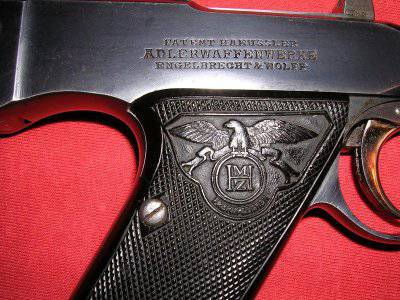 Interesting were the weight and dimensions of the gun, which are not combined with each other, provided that the weapon does not use light alloys. So, with a mass less than 700 grams, the total length of the weapon was 192 millimeters, and height - 125 millimeters. The thickness of the gun was equal to 27 millimeters, and well, the barrel length was small, just 86,3 millimeter. The capacity of the store was equal to eight rounds. The small mass of the pistol should have affected the convenience of handling the weapon, but even with it the pistol turned out to be absolutely inconvenient, since most of its weight was concentrated behind the handle, which was not compensated even by the large angle of inclination of the latter. Because of this, the weapon threw up very strongly when fired, and it was never able to compete with more successful models, which does not make this gun less interesting. However, not only the design of the pistol affected its distribution, in my opinion, the fact that the weapon used its own cartridge, which was not particularly distinguished from the existing ammunition with its characteristics, also played a significant role. So, not only was it necessary to organize the production of the pistol itself, it was also necessary to do ammunition separately, which significantly affected the total cost of the weapon. And although later there appeared samples using more common cartridges, this did not save the weapon.
Interesting were the weight and dimensions of the gun, which are not combined with each other, provided that the weapon does not use light alloys. So, with a mass less than 700 grams, the total length of the weapon was 192 millimeters, and height - 125 millimeters. The thickness of the gun was equal to 27 millimeters, and well, the barrel length was small, just 86,3 millimeter. The capacity of the store was equal to eight rounds. The small mass of the pistol should have affected the convenience of handling the weapon, but even with it the pistol turned out to be absolutely inconvenient, since most of its weight was concentrated behind the handle, which was not compensated even by the large angle of inclination of the latter. Because of this, the weapon threw up very strongly when fired, and it was never able to compete with more successful models, which does not make this gun less interesting. However, not only the design of the pistol affected its distribution, in my opinion, the fact that the weapon used its own cartridge, which was not particularly distinguished from the existing ammunition with its characteristics, also played a significant role. So, not only was it necessary to organize the production of the pistol itself, it was also necessary to do ammunition separately, which significantly affected the total cost of the weapon. And although later there appeared samples using more common cartridges, this did not save the weapon.
